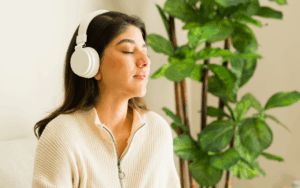
Quiet and Low Sensory Spaces at Events
Events can be loud, bright and stimulating – but not everyone thrives in high-energy environments. Many of our clients are increasingly requesting solutions and spaces that provide moments of calm with a focus on human-centred event design that puts the audience first, and caters to a wide range of sensory needs.
With a growing awareness and understanding of neurodiversity (autism, ADHD, sensory sensitivity, anxiety) and the negative impacts that social media is having on our mental health, it’s never been more important to factor in quiet zones and sensory breaks in our event space and program.
The need for self care and wellbeing has now extended beyond the home and workplace and into our event experiences!
Mini Case Study: University of Melbourne
Back in March, we trialled a low-sensory activation for the University of Melbourne. A dedicated room was allocated for the purpose, with comfy bean bags and noise cancelling headphones in one partitioned section, and art and craft tables set up in another area.
It was such a big hit with the students (and even some staff who snuck in to check it out) that the chill-out space is looking like it will become a regular and much anticipated feature of the University’s events program. A second successful session ran in July, and we have another low-sensory activation booked in for O Week in February 2026!

There are many benefits of incorporating quiet and low sensory experiences into your events, such as:
- Sets an inclusive tone for your brand: Offering personalised spaces and experiences that cater for a diverse audience, recognises that there is no one-size-fits-all approach and shows that you really care about and understand your audience needs.
- Extends time spent at your event: By helping to reduce feelings of overwhelm and overstimulation, and increasing attendees comfort and safety levels, you’ll ensure people not only have a better time but are able to stay for longer – allowing people to take breaks and reset when they need to.
- Increases satisfaction levels and return attendance: By reducing incidents of overwhelm or conflict, you’ll naturally increase enjoyment levels. This leads to more positive feedback and a higher chance of attendees coming back to your event in future.
Six key things to consider when creating quiet and low sensory spaces include:
- Setting – ensure your quiet spaces are set far enough away from loud main stages, activations and speakers. Include natural elements like plants and flowers, or use an outdoor space if available.
- Lighting – avoid bright, strobe or pulsing lights. Instead opt for soft, warm lighting and provide adjustable or dimmable lights to let people customise their experience.
- Sound – being far enough away from any stages, activations and speakers is essential. Using calming music, white noise machines and noise cancelling headphones are great options.
- Scent – avoid strong perfumes and go for neutral or subtle calming smells like lavender or eucalyptus. Good ventilation is also important. (Talk to us about JT. Curation – custom scents from essential oils.)
- Furniture – soft beanbags, low comfortable chairs and floor cushions provide a sense of grounding and safety. Ensure these are not too crowded and there is enough space around each seat.
- Activities – art and crafts, colouring books, simple puzzles and fidget toys are all great low sensory activity options. You could also provide weighted blankets and eye pillows, and yoga mats.
Finally, but most importantly – make sure any staff and volunteers working in these areas are trained and able to support guests!
Wellbeing is no longer a nice-to-have. Quiet spaces support inclusion, help attendees feel safe and valued, and elevate the overall event experience.
If you’d like to incorporate more inclusive elements at your next event, our team can help. Get in touch today: jtproductionmanagement.com
And check out this Blog on Diversity and Inclusion for events for more great tips and ideas.

